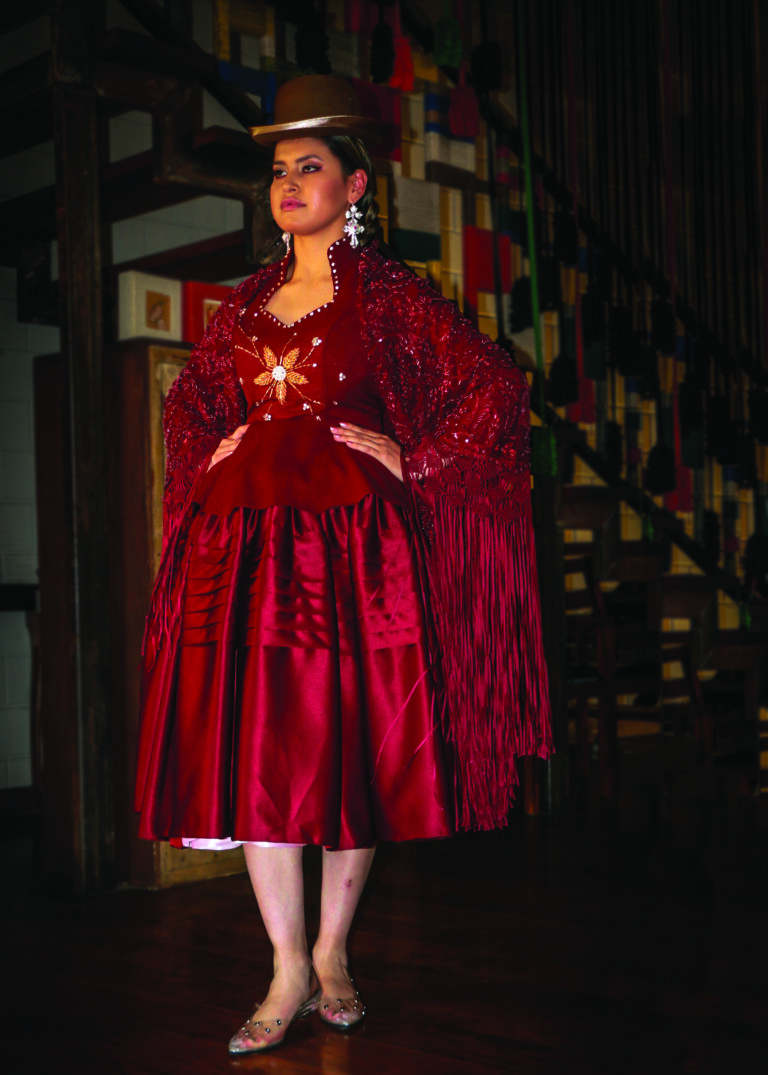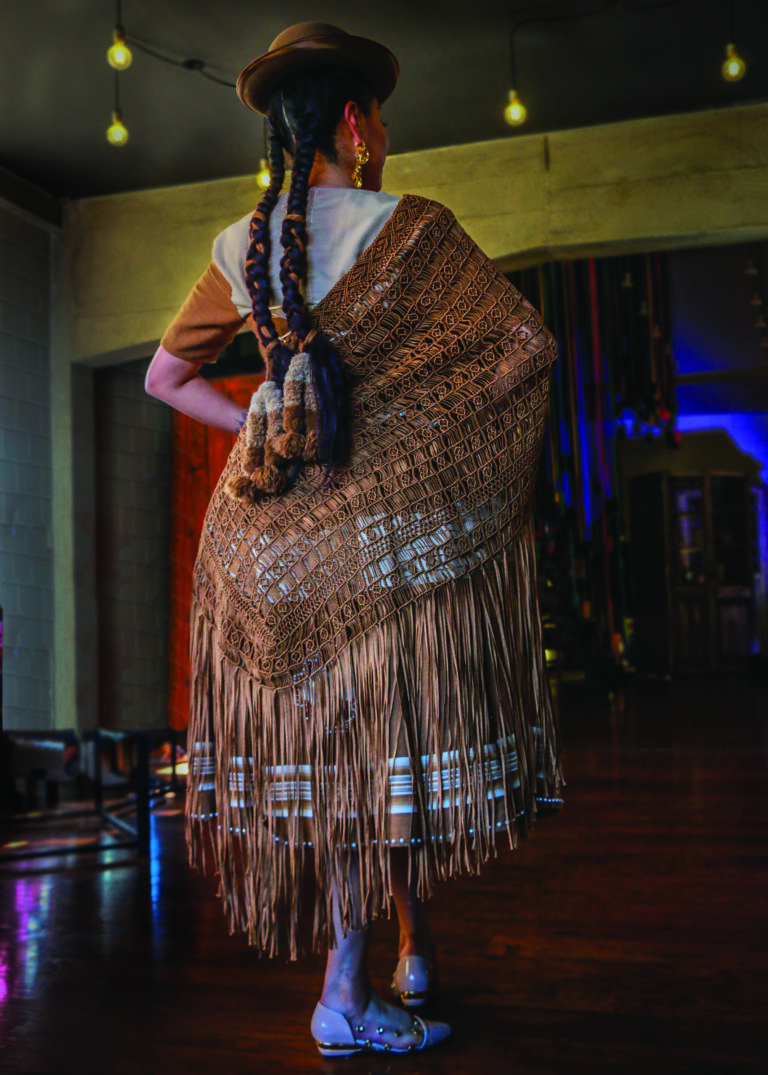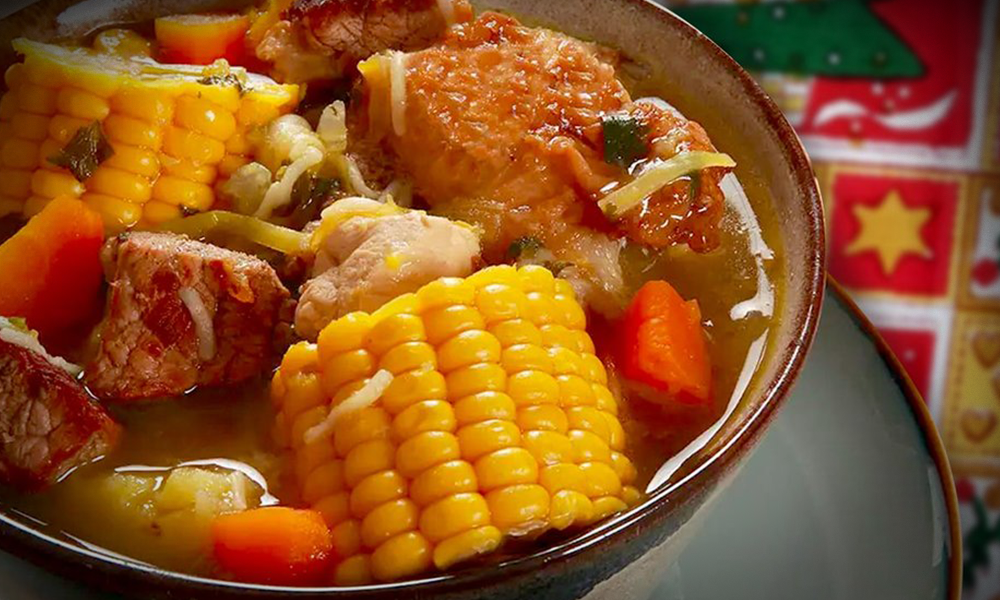

La vestimenta de la mujer de pollera en Bolivia está cargada de historia y significado, es un testimonio vivo de la identidad boliviana, un símbolo cultural arraigado en la rica fusión de influencias coloniales e indígenas, que a través de sus múltiples elementos demuestra una adaptación temporal con apropiación cultural inquebrantable
La procedencia de la palabra “chola”, según Antonio Paredes Candia en su libro “La Chola Boliviana”, señala: “Después de haber revisado varios estudios al respecto, estamos en posición de aseverar que la voz castellana cholo, masculino y chola, femenino, arrancan su origen en la voz de la lengua aimara Chulu (mestizo)… Se debe desechar aquello de que el nombre de cholo y chola, proviene de chulo y chula, simplemente porque algunas prendas que visten ambos individuos tengan semejanza, como el mantón o mantilla con que cubren sus hombros las hembras. El traje de la chola, en su corte, es el mismo que el de la dama española, sólo acortada la saya por aquella, variante que presumiblemente se originó buscando mayor comodidad para realizar mejor las ocupaciones y oficios a que estaba destinada su capa social.”
Por su parte la historiadora Sayuri Loza, refiere que la vestimenta de la chola tiene sus raíces en tradiciones introducidas por la Corona española en el siglo XVI. Si bien la vestimenta de la chola boliviana fue influenciada por las chulas españolas, los orígenes de cada prenda proceden de varias otras regiones.
Las enaguas que provienen de la tradición francesa; la blusa con encajes que proviene de Flandes, región de Europa occidental; la pollera tendría origen mogol creada por musulmanes asentados en la India, quienes en las cruzadas influenciaron a los europeos con la nueva prenda, implementada posteriormente por las mujeres de Europa, las que a su vez con el tiempo transmitieron la falda a las mujeres mestizas durante la colonización. En Bolivia el largo de la pollera es variable por zonas, en el altiplano las usan más largas y en los valles más cortas, sin embargo todas son plisadas y con volumen.
Así también se hace referencia a la manta, esta tendría su origen en china siendo usada como tapiz para paredes o cobertor de muebles, pero tras la conquista de España a Filipinas sería trasladada a territorio español y usada como el mantón de manila por las mujeres españolas, quienes admiraron los bordados finos en las mismas y que a la fecha se preservan tanto en España como en Bolivia, dónde también se realizó el cambio del material en la regiones frías, usándose la manta de vicuña o baby alpaca que además tienen elevados costos.
Si bien es fácil de notar que la vestimenta de la chola boliviana fue impuesta por la cultura española durante la colonia, existen complementos nativos de la cultura andina que fueron introducidos a la vestimenta de la mujer de pollera, como son las tullmas, del vocablo quechua que significa “adorno”, esos que cuelgan al final de las 2 trenzas; y en algunos casos el “topo tipo punzón” una joya de oro como sujetador de la manta, ambos accesorios mantienen parte de la identidad de pueblos aimaras y quechuas desde la época prehispánica.
Un accesorio importante es el sombrero, que diferencia a cada región del país; en La Paz se usa el bombín, modelo creado en Londres y usado en la década de los 30´s por varones como Charles Chaplin, llegó a Bolivia para los trabajadores ferroviarios pero quedaron pequeños, fue así que los comerciantes ofrecieron el producto decorado a las mujeres y son usados hasta hoy en día; en Cochabamba, llevan el sombrero de copa alta color blanco por ser cubierto de yeso y con cintas negras; y en Tarija el sombrero se caracteriza por ser de color caña o plomo.
De igual forma los zapatos, en el caso de las cholas antiguas dónde se usaban botines con tacos y actualmente usan zapatillas planas tipo torero que nuevamente reflejan la influencia española, en los valles usan tipo sandalias.
En Bolivia encontramos a las mujeres de pollera en diferentes versiones según cada región y vale la pena poner atención al desfile de trajes típicos en alguna entrada folklórica, donde se pueden ver versiones diferentes de cholas, sin embargo debemos destacar que este modo de vestir sobrevive por más de 500 años y en la actualidad importantes marcas de diseñadores y diseñadoras basan o se inspiran para nuevas colecciones en esta bella caracterización cultural femenina boliviana, que si bien su origen proviene de varios países, la vestimenta de chola en su conjunto es hoy por hoy reconocido mundialmente como ícono cultural boliviano.
The origin and the history of Bolivian Chola clothing
The clothing of the woman dressing “pollera” in Bolivia is loaded with history and meaning, it is a living testimony of Bolivian identity, a cultural symbol rooted in the rich fusion of colonial and indigenous influences, which through its multiple elements shows a temporary adaptation with unwavering cultural appropriation.
The origin of the word “chola”, according to Antonio Paredes Candia in his book “La Chola Boliviana”, points out that: “After having reviewed several studies on the matter, we are in a position to assert that the Spanish voice “cholo”, masculine and chola, feminine , can have their origin to the Aymara language Chhulu (half-blood)… We must discard the idea that the names “cholo” and “chola” come from the words “chulo” or “chula”, simply because some garments worn by both individuals have a similarity, such as the shawl or mantilla with which females cover their shoulders. The dress of the chola, in design, is the same as the one worn by a Spanish lady, only that the skirt has been shortened for the first one as variant that was presumably looking for a greater comfort to carry out the occupations and trades for which her social status was destined. ”
Meanwhile, historian Sayuri Loza says that chola clothing has its roots in traditions introduced by the Spanish Crown in the 16th century. While Bolivian “chola” clothing was influenced by Spanish “chulas”, the origins of each garment comes from several other regions.
The petticoats that come from the French tradition; the lace blouse that comes from Flanders, a region of Western Europe; The skirt would have Mughal origin, created by Muslims settled in India, who during the Crusades influenced the Europeans with the new garment, later implemented by the women of Europe, who in turn, over time, transmitted the skirt to the so called “half-blood” women during the colonization. In Bolivia the length of the skirt varies by area, in the highlands they are worn longer and in the valleys shorter, however they are all pleated and voluminous.
This is also how the shawl is referred to, it would have its origin in China being used as a wall tapestry or furniture cover, but after Spain’s conquest of the Philippines it would be transferred to Spanish territory and used as the Manila shawl by Spanish women. , who admired the fine embroidery on them and which to this day are preserved in both Spain and Bolivia, where the material was also changed in cold regions, using vicuña or baby alpaca shawls, which also have a high cost.
Although it is easy to notice that the clothing of the Bolivian “chola” was imposed by Spanish culture during the colony, there are native accessories from the Andean culture that were introduced to the clothing of the pollera woman, such as the “tullmas”, from the Quechua word which means “ornament”, those that hang at the end of 2 braids falling from their heads; and in some cases the clasp, a gold jewel as a holder for the shawl, both accessories are still part of the identity of the Aymara and Quechua peoples since pre-Hispanic times.
An important accessory is the hat, which differentiates each region of the country; In La Paz, the bowler hat is used, a model created in London and used in the 1930s by men like Charles Chaplin. It arrived to Bolivia with railway workers but they were too small, so merchants offered the decorated product to women; In Cochabamba, they wear high-topped hats that are white because they are covered in plaster and have black ribbons; and in Tarija the hat is characterized by being cane or lead colored.
Likewise, the shoes, in the case of the ancient “cholas” , they used to wear ankle boots with heels and currently they wear flat bullfighter-type sneakers that again reflect the Spanish influence, in the valleys they wear sandals.
In Bolivia we find women in skirts in different versions according to each region and it is worth paying attention to the parade of typical costumes in some folklore parades, where you can see different versions of “cholas”, however we must highlight that this way of dressing has survived for more than 500 years and currently important designer brands base or are inspired for new collections on this beautiful Bolivian female cultural characterization, which although its origin comes from several countries, “chola” clothing as a whole is today recognized worldwide as a Bolivian cultural icon.




